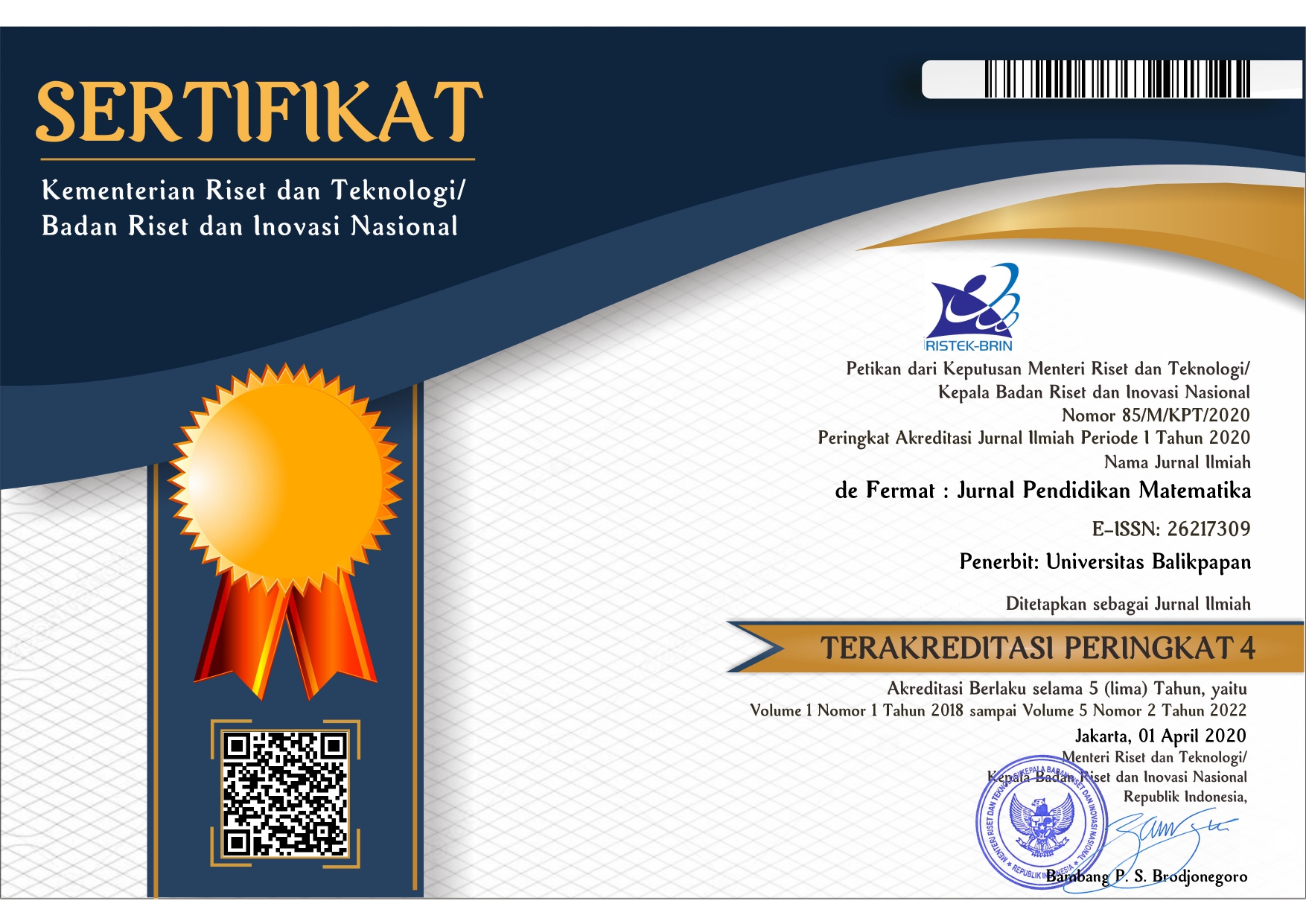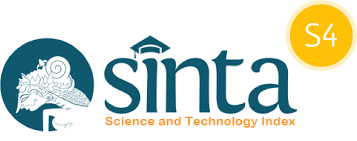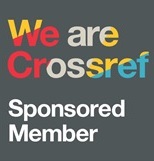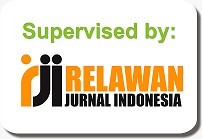ANALYSIS OF MATHEMATICAL CREATIVE THINKING ABILITY IN TERMS OF SELF-REGULATED LEARNING IN THE CREATIVE PROBLEM-SOLVING LEARNING MODEL
DOI:
https://doi.org/10.36277/defermat.v5i2.288Keywords:
Mathematical Creative Thinking Ability, SRL, CPSAbstract
This research aims to test the effectiveness of Creative Problem Solving (CPS) learning and to describe students' mathematical creative thinking skills in terms of Self-Regulated Learning (SRL). The method used is a mixed method research with a sequential explanatory design. In this research, 6 research subjects were taken based on the level of SRL in class VIII A students of SMP Negeri 1 Tayu, Pati Regency for the academic year 2022/2023. The results showed that (1) the CPS learning model was effective on students' mathematical creative thinking abilities, and (2) research subjects with high SRL categories were able to meet all indicators of mathematical creative thinking ability, namely fluency, flexibility, originality, and elaboration; research subjects with moderate SRL category only met three indicators of mathematical creative thinking ability, namely fluency, originality, and elaboration; research subjects with low SRL category can’t meet all indicators of mathematical creative thinking ability. Recommendations to students with low levels of SRL can’t meet all indicators of mathematical creative thinking ability by giving assignments independently and doing peer teaching.
References
Ahmar, D. S. (2016). The relationship between Self Regulation with Creative Thinking Ability of Students in Chemistry Class XI IPA at Takalar. Jurnal Sainsmat, 5(1), 7–23.
Al-kreimeen, R. A. (2014). The Relationship Between Individual Creativity and Self-Regulation from Grade Nine Students Viewpoints in Jordan. IPEDR, 78(17), 85–90. https://doi.org/10.7763
Atiyah, A., & Nuraeni, R. (2022). Kemampuan berpikir kreatif matematis dan self-confidence ditinjau dari kemandirian belajar siswa. Jurnal Inovasi Pembelajaran Matematika: PowerMathEdu, 1(1), 103–112. https://doi.org/10.31980/powermathedu.v1i1.1920
Eladl, A. M., & Polpol, Y. S. (2020). The Effect of Self-Regulated Learning Strategies on Developing Creative Problem Solving and Academic Self-Efficacy Among Intellectually Superior High School Students. International Journal of Psycho-Educational Sciences |, 9(1), 97–106. https://www.journals.lapub.co.uk/index.php/IJPES
Fattayati, F., Masrukan, M., & Dwijanto, D. (2021). Mathematical Creative Thinking Ability and Self-Regulation Character of Class X Students in Problem Based Learning assisted by Google Classroom in terms of Goal Orientation. Unnes Journal of Mathematics Education Research, 10(2), 144–150. http://journal.unnes.ac.id/sju/index.php/ujmer
Faturohman, I., Ekasatya, D., & Afriansyah, A. (2020). Mosharafa: Jurnal Pendidikan Matematika Peningkatan Kemampuan Berpikir Kreatif Matematis Siswa melalui Creative Problem Solving. Mosharafa: Jurnal Pendidikan Matematika, 9(1), 107–118. http://journal.institutpendidikan.ac.id/index.php/mosharafa
Florida, R., Mellander, C., & King, K. (2015). The Global Creativity Index 2015. Martin Prosperity Institute, 1–64. http://martinprosperity.org/media/Global-Creativity-Index-2015.pdf
Hendriana, H. et al. (2016). Hard Skill dan Soft Skills Matematika siswa. Cimahi: STKIP Siliwangi Press.
Henriksen, D., Richardson, C., & Mehta, R. (2017). Design thinking: A creative approach to educational problems of practice. Thinking Skills and Creativity, 26, 140–153. https://doi.org/10.1016/j.tsc.2017.10.001
Huang, N. tang, Chang, Y. shan, & Chou, C. hui. (2020). Effects of creative thinking, psychomotor skills, and creative self-efficacy on engineering design creativity. Thinking Skills and Creativity, 37(March), 100695. https://doi.org/10.1016/j.tsc.2020.100695
Khalid, M., Saad, S., Abdul Hamid, S. R., Ridhuan Abdullah, M., Ibrahim, H., & Shahrill, M. (2020). Enhancing creativity and problem solving skills through creative problem solving in teaching mathematics. Creativity Studies, 13(2), 270–291. https://doi.org/10.3846/cs.2020.11027
Kim, S., Choe, I., & Kaufman, J. C. (2019). The development and evaluation of the effect of creative problem-solving program on young children’s creativity and character. Thinking Skills and Creativity, 33(August 2018), 100590. https://doi.org/10.1016/j.tsc.2019.100590
Laar, E., Deursen, A. J. A. M., Dijk, J. A. G. M., & Haan, J. (2017). The relation between 21st-century skills and digital skills: A systematic literature review. Computers in Human Behavior, 72, 577–588. https://doi.org/10.1016/j.chb.2017.03.010
Munahefi, D. N., Kartono, Waluya, B., & Dwijanto. (2022). Analysis of Self-Regulated Learning at Each Level of Mathematical Creative Thinking Skill. Bolema - Mathematics Education Bulletin, 36(72), 581–601. https://doi.org/10.1590/1980-4415v36n72a26
Munahefi, D. N., Waluya, S. B., & Rochmad. (2018). Analysis of creative mathematic thinking ability in problem based learning model based on self-regulation learning. Journal of Physics: Conference Series, 983(1). https://doi.org/10.1088/1742-6596/983/1/012161
Nugraheni, N., Waluya, S. B., & Walid, W. (2021). HOTS study primary teacher education UNNES students based on self-regulated learning. Jurnal Prima Edukasia, 9(1), 127–134. https://doi.org/10.21831/jpe.v9i1.36359
OECD. (2019). PISA 2018 Assessment and Analytical Framework. OECD Publishing. https://doi.org/https://doi.org/10.1787/b25efab8-en
Purwaningsih, W. I., & Supriyono, S. (2020). Analisis kemampuan berpikir kreatif siswa dalam menyelesaikan masalah matematika. Jurnal Pendidikan Surya Edukasi (JPSE), 6(2), 157–167. https://doi.org/10.37729/jpse.v6i2.6803
Shoimin, A. (2014). 68 Model Pembelajaran Inovatif dalam Kurikulum 2013. Yogyakarta: Ar-Ruzz Media.
Sitorus, J., & Masrayati. (2016). Students’ creative thinking process stages: Implementation of realistic mathematics education. Thinking Skills and Creativity, 22, 111–120. https://doi.org/10.1016/j.tsc.2016.09.007
Situmorang, A. S., & Gultom, S. P. (2018). Desain Model Pembelajaran Creative Problem Solving terhadap Kemampuan Pemahaman Konsep Mahasiswa FKIP UHN. Jurnal Penelitian Bidang Pendidikan, 24(2), 103–110. https://jurnal.unimed.ac.id/2012/index.php/penelitian/article/view/13949/11604
Sundayana, R. (2018). Kaitan antara Gaya Belajar, Kemandirian Belajar, dan Kemampuan Pemecahan Masalah Siswa SMP dalam Pelajaran Matematika. Mosharafa: Jurnal Pendidikan Matematika, 5(2), 75–84. https://doi.org/10.31980/mosharafa.v5i2.262
Susanti, E., Waluya, S. B., & Masrukan. (2020). Analysis of Creative Thinking Ability Based on Self-Regulation in Model Eliciting Activity Learning with Performance Assessment. Unnes Journal of Mathematics Education Research, 9(2), 208–215. https://journal.unnes.ac.id/sju/index.php/ujmer/article/view/34021
Tabach, M., & Friedlander, A. (2017). Algebraic procedures and creative thinking. ZDM - Mathematics Education, 49(1), 53–63. https://doi.org/10.1007/s11858-016-0803-y
Treffinger, D. J., Isaksen, S. G., & Dorval, K. B. (2010). Creative Problem Solving ( CPS Version 6 . 1 TM ) A Contemporary Framework for Managing Change Creative Problem Solving ( CPS )—. Florida: Center for Creative Learning, Inc. and Creative Problem Solving Group, Inc.
Utami, A. F., Masrukan, & Arifudin. (2014). Meningkatkan Kemampuan Berpikir Kreatif Siswa Melalui Pembelajaran Model Taba Berbantuan Geometer’s Sketchpad. Kreano: Jurnal Matematika Kreatif-Inovatif, 5(1), 63–72. https://doi.org/10.15294/kreano.v5i1.3279
Utami, F., Ainy, C., & Mursyidah, H. (2019). Efektivitas penerapan model pembelajaran creative problem solving (cps) terhadap hasil belajar siswa pada materi luas permukaan bangun ruang sisi datar. Jurnal Math Educator Nusantara: Wahana Publikasi Karya Tulis Ilmiah Di Bidang Pendidikan Matematika, 5(01), 01. https://doi.org/10.29407/jmen.v5i01.12332
Wang, H.-C., Rosé, C. P., & Chang, C.-Y. (2011). Agent-based dynamic support for learning from collaborative brainstorming in scientific inquiry. International Journal of Computer-Supported Collaborative Learning 2011 6:3, 6(3), 371–395. https://doi.org/10.1007/S11412-011-9124-X
Downloads
Published
Versions
- 2022-12-31 (3)
- 2022-12-31 (2)
- 2022-12-31 (1)















